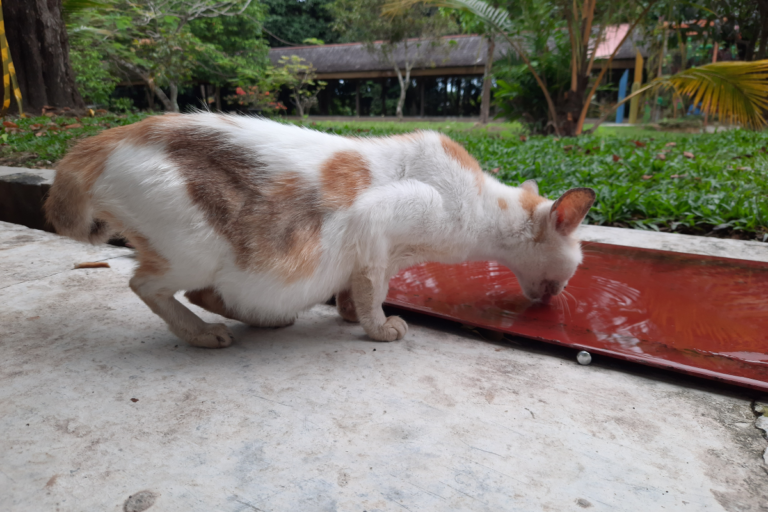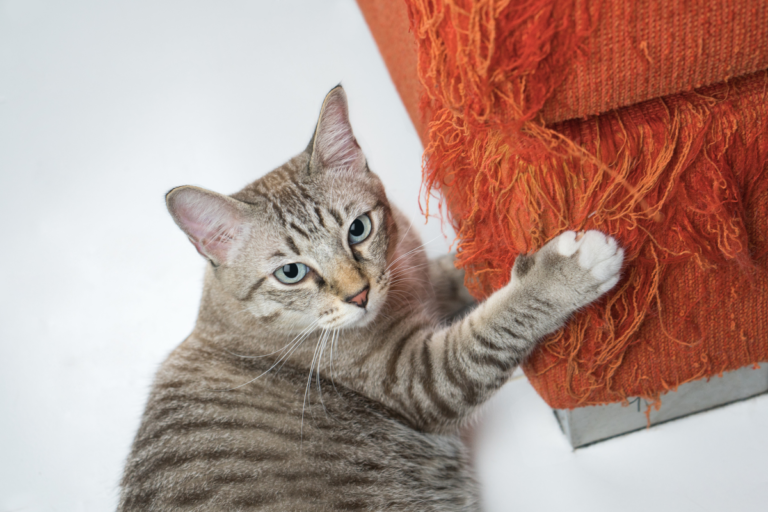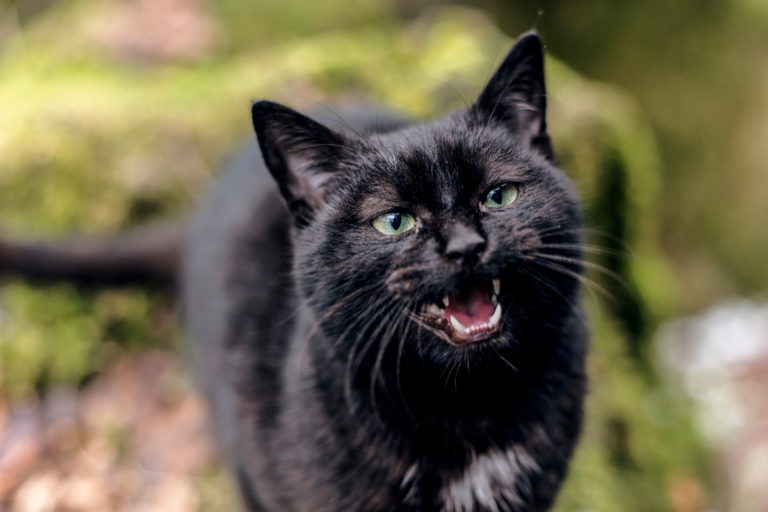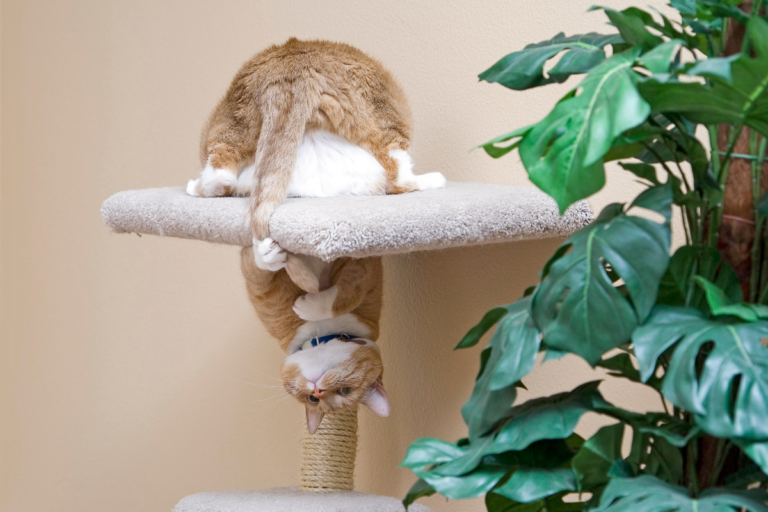Transforming Cat Aggression: Empowering Solutions for Cat Owners
Understanding Cat Aggression
Cats, those furry little drama queens, can sometimes let their claws do the talking. For cat parents, understanding why Fluffy turns into a tiny savage can be key in keeping the peace at home. Let’s break down how you can spot and manage their various temper tantrums.
Types of Aggression
Our feline buddies have moods just like we do, each with its own triggers. Here’s the lowdown on their feisty behavior:
- Play Aggression: Think of kittens doing zoomies and treating your feet as their personal chew toys. It’s like a tiny, harmless crime spree with no ill intentions.
- Fear Aggression: When something scares your kitty, like a vacuum cleaner or the neighbor’s dog, they’ll puff up, hiss, or swipe to shield themselves.
- Petting-Induced Aggression: Ever pet your cat and suddenly get chomped? They’re likely saying “enough,” in a not-so-subtle way.
- Pain-Induced Aggression: Touch a kitty’s sore spot and you’re likely to get a quick lesson about personal space.
- Territorial Aggression: Cats can be major homebodies and get cranky if someone dares to trespass, whether it’s another pet or a guest.
- Redirected Aggression: They might take out their frustrations on you if they spot something provoking, like a bird outside, that they can’t actually slap.
- Status-Induced Aggression: It’s a cat-eat-cat world, and sometimes they’ll bully to show who’s boss.
- Maternal Aggression: Momma cats are fiercely protective, so think twice before getting near the kittens.
- Inter-Cat Aggression: Sometimes your cats just don’t vibe and might have spats over who’s sleeping on the best windowsill.
Just rang a bell? Hop over to our other pages for playful shenanigans, fierce territorial habits, and protective mom tactics.
Communication of Aggression
Cats are masters at the silent treatment, but their actions speak volumes. Learn what to watch for, so you can tame the chaos before it erupts.
Body Language Cues
- Eyes: Wide-eyed and shifty? That’s a red flag for trouble ahead.
- Ears: Pin those ears back and they’re in defense mode.
- Tail: Picture a frenzied tail like an angry flag waving you off.
- Body Posture: A Halloween-cat stretch means they’re gearing up for battle.
Vocal Cues
- Purring: It sounds sweet, but in a tense moment, they’re nervously telling you to back off.
- Growling: A growl is their “do not disturb” sign with a hint of menace.
- Hissing: Loud and scary, it’s their megaphone shout of “keep your distance.”
Physical Contact
- Pouncing: Might be play or their way of testing boundaries.
- Biting: From gentle to grizzly bites, it’s their voice when they’re annoyed.
- Scratching: It’s both a warning and their way to claim their turf.
There’s always more to uncover about your cat’s antics. Dive into deciphering meows and territorial scratching matches.
Getting tuned into these cat signals can be your best trick to keeping your furry friend chill and content. Happy fur parenting!
Factors Influencing Aggression
Understanding what makes a cat go from purr to hiss can be like unlocking a mystery novel. It’s not just a guessing game—some hidden factors can set your kitty off. Let’s chat about how different breeds and quirks influence that feisty behavior.
Breeds and Aggression
You ever notice how some cats just seem a bit more spicy than others? Turns out, your feline’s breed might be the culprit. Breeds like the Abyssinian and Siamese can have a bit of sass baked in compared to the more laid-back Ragdolls, Sphynx, Burmese, and Maine Coons (PetMD). But hey, don’t label them just yet. Breed is just one piece of the puzzle.
| Breed | Aggression Vibes |
|---|---|
| Abyssinian | Spicy |
| Siamese | Spicy |
| Ragdoll | Chill 🌿 |
| Sphynx | Chill 🌿 |
| Burmese | Chill 🌿 |
| Maine Coon | Chill 🌿 |
| Domestic Shorthair | Mixed Bag |
| Domestic Longhair | Mixed Bag |
If you’re hoping for a purring lap cat, a Ragdoll, Sphynx, or Maine Coon might be your new bestie. But remember, kitty personality isn’t just about pedigree. Things like their environment, how they’re raised, or an unexpected vet trip can all make a difference.
Reasons for Sudden Aggression
Ever had your furry pal flip from sweet kitty to clawed fury? It can freak you out, but there’s usually a reason behind the madness. Factors turning your purring friend into the Tasmanian devil can include stress, injury, or even “I’ve moved house” blues (PetMD).
| Cause | What’s Happening? |
|---|---|
| Pain | Ouchies from injury or not feeling well |
| Cognitive Woes | That pesky old age messing with kitty’s mind |
| New Digs | Adjusting to a fresh pad |
| Stress Mess | Life’s little and big freakouts |
| Petting Overload | Too much lovin’, not enough consent |
| Mood Swings | Thanks, hormones! |
| Home Turf Battles | Trying to defend their castle |
Other triggers include a fussy brain, new roommates (furry or otherwise), or feeling like they’re falling down the social ladder. If suddenly, Mr. Fluffball’s acting out, a chat with your vet might untangle the mystery. And for some peace-making tips, check out this nifty guide on cat biting.
Deciphering what ticks off your kitty can make your home feel like a peaceful paradise again. Dive deeper into cat behavior for more tricks to get along with your fluffy family member.
Managing Different Aggression Types
Play Aggression
Play aggression often leaves cat owners scratching their heads. Imagine your little furball suddenly turning into a tiny tiger — stalking, chasing, even giving a cheeky bite. These antics are a natural part of young feline life, but they can sometimes lead to scratching more than just the surface — ouch! Kittens learn by playing, and those not raised with siblings might miss out on lessons of what’s too rough. (ASPCA)
Playful aggression is the name of the game for kittens and young cats. Without littermates, some just don’t pick up on when playtime turns into “argh, too much!” antics. (Cornell Feline Health Center)
| Key Factors | Description |
|---|---|
| Age | Young cats and kittens are the main culprits |
| Socialization | Absence of sibling interaction |
| Behavior | Includes things like stalking and biting |
Fear Aggression
Fear aggression bursts forth when a cat sees spooky threats with no escape route. Often, previous spats with danger shape this hair-raising reaction, making it tricky to pinpoint cause and effect. (PetMD) Easing fear aggression means spotting and sidestepping spooky triggers. A gentle approach like easing the cat into calming environments and giving goodies for not freaking out works wonders. (Cornell Feline Health Center)
| Key Factors | Description |
|---|---|
| Triggers | Threats that make them go “yikes!” |
| Management | Staying out of terrifying situations |
| Techniques | Hand out treats for calm, collected behavior |
Pain-Induced Aggression
When pain is lurking, watch for a grumpy cat! This claws-out response is a furry friend trying to shield sore spots from pesky prods. You can curb this by steering clear of those tender zones and teaming up with a vet to tackle the pain head-on. (Cornell Feline Health Center)
| Key Factors | Description |
|---|---|
| Triggers | Aches and pains turning them into cranksters |
| Management | Avoid touching sore spots |
| Solutions | Vet-approved pain management plan |
For more paws-on advice and strategies to tackle aggression and get the low-down on other feline antics, check out our guides on cats behavior and cat biting. Plus, uncover ways to hush those mysterious cat meows for a serene space you and your whiskered buddy can enjoy.
Addressing Specific Forms of Aggression
Being a cat owner, I’ve had my fair share of kitty-tantrums, each with its unique vibe and tactics to calm the waters. Let’s dig into the unique ways our feline friends express themselves.
Territorial Attitude
Cats can get a bit narky when someone steps on their turf. We’re talking about your cat going all Rambo on other cats, dogs, or even Aunt Mildred who’s just stopped by for tea.
Common territorial flare-ups include:
- Stalk and pounce
- Whack-a-mole style swatting
- Surprise hissing matches
| Intrusion | What the Cat Does |
|---|---|
| Nosy Neighbor Cats | Stalking, Whacking |
| Barking Dogs | Chasing, Ambushing |
| Random People | Hissing, Growling |
Figuring out what’s got your kitty’s fur ruffled and slowly easing them into accepting the new presence can make a world of difference. If your cat insists on being the neighborhood enforcer, getting some professional scoops from a vet on cat psychology could be worthwhile.
Redirected Tantrums
Redirected aggression is when cats take their frustration about something and decide to share the love with anyone standing a tad too close. Not exactly the kind of sharing I signed up for.
To tackle this type of outburst:
- Pinpoint and, if possible, nix what initially ticked meowster off.
- Give kitty some cooldown time away from their chosen victim.
- Distract your furball using treats and lots of snuggle time, praising them for chilling out.
You’ll find more wisdom on wrangling this behavior in our cat behavior article.
Mama Cat Defensive Mode
New mama cats are usually ready to go full mama bear if they feel any threat to their tiny, squeaky bundles.
| Threat | Mama Cat’s Moves |
|---|---|
| People | Swatting, Hissing |
| Other Critters | Growling, Chasing |
Here’s the playbook:
- Keep your hands off the kittens for a bit.
- Give them a calm, private space for that all-important nap time.
- Watch for stress signals from mama and address them with love.
More tips and tricks available in our pregnant cat behavior section.
By spotting and managing these aggressive bouts, you could save yourself lots of scratched arms and create a happy, relaxed home. If you’re on the lookout for more advice on cat drama, check out topics like cat biting or male cat spraying.






